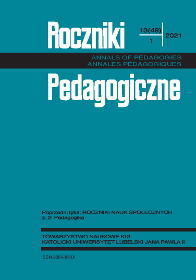Environmental Alienation of Children in the Early School Age – Reflections on the Passenger Generation
Main Article Content
Abstract
The presented paper discusses the problem of the quality of contemporary children – natural environment relationship. The text includes results from Polish and foreign studies demonstrating the level of children’s environmental knowledge and increasing tendency to limit the time spent in the natural environment. It also covers the issue of response to this situation, the recognition of the need for designation of new places for children to play as well as enabling nature observation.
Article Details
Issue
Section
Articles
References
Ballouard, J-M., Brischoux, F., Bonnet, X. (2011). Children Prioritize Virtual Exotic Biodiversity over Local Biodiversity. PLoS ONE, 6(8): e23152.
Balmford, A., Clegg L., Coulson T., Taylor J. (2002). Why Conservationists Should Heed Pokemon. New York: Science.
Bento, G., Dias, G. (2017). The importance of outdoor play for young children’s healthy development. Porto Biomed. Journal, 2(5), 157-160.
Carel, S. (2018). Scottish GPs to begin prescribing rambling and birdwatching. The Guardian, https://www.theguardian.com/uk-news/2018/oct/05/scottish-gps-nhs-begin-prescribing-rambling-birdwatching (dostęp: 12.11.2018).
Domeracki, P. (2006). Wokół pojęcia alienacji ekologicznej. Humanistyka i Przyrodoznawstwo, 12, 193-205.
Frączak, M., Hędrzak, M. (2013). Edukacja plenerowa dzieci z terenu miasta Krakowa – efekty i perspektywy rozwoju projektu „Lasy dla przedszkolaków”. Studia i Materiały CEPL w Rogowie, 34(1), 31-38.
Hull, Z. (1996). Współczesny kryzys ekologiczny a technika. Ostrołęckie Towarzystwo Naukowe im. Adama Chętnika. Zeszyt Naukowy, 10, 177-187.
Kosmala, M. (2014). Naturalne place zabaw – poradnik, Warszawa, http://placezabaw.um.warszawa.pl/files/Naturalne_place_zabaw_internet.pdf, (dostęp: 12.12.2018).
Kuderowicz, Z. (1996). Filozofia wobec zagrożeń cywilizacyjnych. Studia Filozoficzne, 12, 151-157.
Matthew, S.C. (1985) Adventure Playgrounds vs Traditional Playgrounds, 1985, UNF Graduate eses and Dissertations.
Nalaskowski, A. (2017). Szkoła Laboratorium: od działań autorskich do pedagogii źródeł. Kraków: Oficyna Wydawnicza „Impuls”.
Ohly, H., White, M.P., Wheeler, B.W., Bethel, A., Ukoumunne, O.C., Nikolaou, V., Garside, R. (2016). Attention Restoration Theory: A systematic review of the attention restoration potential of exposure to natural environments. Journal of Toxicology and Environmental Health. Part B.
Park, J.B., Tsunetsugu, Y., Kasetani, T., Kagawa, T., Miyazaki, Y. (2009). The physiological effects of Shinrin-yoku (taking in the forest atmosphere or forest bathing): evidence from field experiments in 24 forests across Japan. Environ Health Prev Med, 15.
Report to Natural England on Childhood and Nature: A Survey on Changing Relationships With Nature Across Genterations (2009).
Balmford, A., Clegg L., Coulson T., Taylor J. (2002). Why Conservationists Should Heed Pokemon. New York: Science.
Bento, G., Dias, G. (2017). The importance of outdoor play for young children’s healthy development. Porto Biomed. Journal, 2(5), 157-160.
Carel, S. (2018). Scottish GPs to begin prescribing rambling and birdwatching. The Guardian, https://www.theguardian.com/uk-news/2018/oct/05/scottish-gps-nhs-begin-prescribing-rambling-birdwatching (dostęp: 12.11.2018).
Domeracki, P. (2006). Wokół pojęcia alienacji ekologicznej. Humanistyka i Przyrodoznawstwo, 12, 193-205.
Frączak, M., Hędrzak, M. (2013). Edukacja plenerowa dzieci z terenu miasta Krakowa – efekty i perspektywy rozwoju projektu „Lasy dla przedszkolaków”. Studia i Materiały CEPL w Rogowie, 34(1), 31-38.
Hull, Z. (1996). Współczesny kryzys ekologiczny a technika. Ostrołęckie Towarzystwo Naukowe im. Adama Chętnika. Zeszyt Naukowy, 10, 177-187.
Kosmala, M. (2014). Naturalne place zabaw – poradnik, Warszawa, http://placezabaw.um.warszawa.pl/files/Naturalne_place_zabaw_internet.pdf, (dostęp: 12.12.2018).
Kuderowicz, Z. (1996). Filozofia wobec zagrożeń cywilizacyjnych. Studia Filozoficzne, 12, 151-157.
Matthew, S.C. (1985) Adventure Playgrounds vs Traditional Playgrounds, 1985, UNF Graduate eses and Dissertations.
Nalaskowski, A. (2017). Szkoła Laboratorium: od działań autorskich do pedagogii źródeł. Kraków: Oficyna Wydawnicza „Impuls”.
Ohly, H., White, M.P., Wheeler, B.W., Bethel, A., Ukoumunne, O.C., Nikolaou, V., Garside, R. (2016). Attention Restoration Theory: A systematic review of the attention restoration potential of exposure to natural environments. Journal of Toxicology and Environmental Health. Part B.
Park, J.B., Tsunetsugu, Y., Kasetani, T., Kagawa, T., Miyazaki, Y. (2009). The physiological effects of Shinrin-yoku (taking in the forest atmosphere or forest bathing): evidence from field experiments in 24 forests across Japan. Environ Health Prev Med, 15.
Report to Natural England on Childhood and Nature: A Survey on Changing Relationships With Nature Across Genterations (2009).

